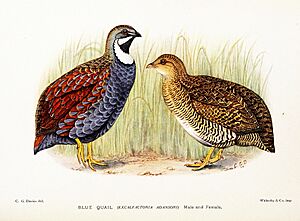Blue quail facts for kids
The blue quail is a small bird. It is also called the African blue quail. You can find it in sub-Saharan Africa. It belongs to the Phasianidae family, which includes pheasants and partridges.
Quick facts for kids Blue quail |
|
|---|---|
 |
|
| Conservation status | |
| Scientific classification | |
| Genus: |
Synoicus
|
| Species: |
adansonii
|
| Synonyms | |
|
|
Contents
About the Blue Quail's Name
Scientists first described the blue quail in 1851. Two brothers, Jules Verreaux and Édouard Verreaux, gave it its scientific name. It is named after Michel Adanson. He was a French scientist who studied nature.
Over time, scientists have changed the blue quail's classification. They now place it in the Synoicus group. This group also includes the king quail and the brown quail. The blue quail is a unique species. It does not have any subspecies.
Where Blue Quails Live
You can find the blue quail in sub-Saharan Africa. Its home range stretches from Sierra Leone to Ethiopia. It also goes south to Zambia and east to Kenya.
Blue quails do not live in very dry places. They prefer grasslands and open fields. These birds usually live close to rivers or other water sources.
What Blue Quails Look Like
The blue quail is a small bird. It is about 14 to 16.5 centimeters (5.5 to 6.5 inches) long. It weighs around 43 to 44 grams (1.5 ounces). Its legs are yellow. Young birds have brown eyes. Breeding males have red eyes.
Male and female blue quails look different. This is called sexual dimorphism.
- Males: Most of the male's feathers are dark blue-gray. They have reddish-brown patches on their wings. Males have a black beak and a brown head. Their throat is black and white. They also have a white patch on their chest. Their flight feathers are brown.
- Females: The female's forehead, neck, and sides are orange-brown. Her head is brown with black spots. Her beak is brownish. Her belly is light brown with black stripes. Her back has black and reddish-brown spots and streaks.
Young blue quails look similar to the females.
How Blue Quails Behave
Blue quails are migratory birds. They move to different areas when the rainy season starts. They also move again early in the dry season.
They eat a variety of foods. Their diet includes seeds, leaves, and insects. They also eat small snails.
The blue quail makes a special sound. It is a high-pitched whistle, like kew kew yew. When it is startled and flies away, it makes a tir-tir-tir sound.
Blue quails usually have one mate for life. Their nest is a simple scrape on the ground. Females usually lay eggs at the start of the rainy season. A female lays about 3 to 9 olive-brown eggs. The eggs have small reddish and purplish spots. The female sits on the eggs for about 16 days. Baby quails are born ready to move around. This means they are precocial.
Blue Quail's Status
The blue quail lives in a very large area. Its population seems to be stable. Because of this, the IUCN Red List of Threatened Species lists the blue quail as a species of "least concern." This means it is not currently at risk of extinction.


